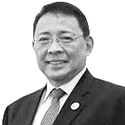
Signs And Wonders
By Diwa C. Guinigundo

Yes, the International Monetary Fund (IMF) declared that the collapse of the two big American banks and the contagion in Europe exacerbated the global economic outlook this year and the next. What could have been a soft landing for the world economy this year might not materialize, as its tentative signs have dissipated given “stubbornly high inflation and recent financial sector turmoil,” in addition to the protracted Russian invasion of Ukraine and three years of COVID.
Reuters shared this emphasis as it chose to describe the financial component as adding layer of uncertainty to what is unfolding as assessed by the Fund in the World Economic Outlook (WEO), but the odds are stacked against global economic recovery. As its Global Financial Stability Report pointed out, financial conditions have become more volatile as market sentiment sinks.
The Fund was as frank as admitting that this year, the recovery could be “rocky.” We should know that when the ground is rocky, the ride is riddled with jolts and irregular movements. It could be as bumpy as a turbulent flight which is expected to be up to three times as violent in the next few decades because of global warming. The so-called clear-air turbulence (CAT) becomes more unpredictable because the jet stream is modified, and the aircraft’s altitude and motion are correspondingly altered. Unlike storms and atmospheric pressures which can be detected using radar and other equipment, CAT seems to just appear with no visible cause. The pilots have no time to warn the passengers to fasten their seatbelts.
Fortunately, the world economy is now forewarned that the ride this year could be jolty.
The baseline forecast for global growth is now a decline from 3.4% in 2022 to 2.8% in 2023 before stabilizing at 3% in 2024. If the emerging market and developing economies (EMDEs) are building up their hope in external trade with their big trading partners, the IMF could be a dampener. Growth in advanced economies may slow down from 2.7% to less than half at 1.4% next year. If the financial sector stress continues, which to the Fund is quite plausible, global growth may further slide down to only 2.5% and the advanced economies may show further deterioration to less than 1%.
Thus, the prospects for the EMDEs derive from their own domestic resiliency and the impact of external forces. The US is leading what may be described as a great growth moderation, restrained at 1.6% this year from last year’s 2.1%. The Euro area is expected to show a sharp hesitation, from 3.5% in 2022 to only 0.8% in 2023, with Germany probably going into a mild recession, just like the UK. While Canada and the rest of the advanced economies are also moderating this year, Japan is forecast to improve from 1.1% last year to 1.3% this year.
The WEO places the growth of EMDEs at 3.9% this year versus last year’s 4%. Even with China and Russia’s strong recovery, aided by stronger performance of EMD Asia as well as EMD Europe, India’s unfavorable prospects and those in Latin America and the Caribbean as well as in the Middle East and Central Asia kept the EMDEs’ contribution to global growth rather moderate.
This much could be said of the implications of geopolitical fragmentation based on the Fund’s recent research. Geopolitical fragmentation is everything we see and hear, that which causes tension in both political and economic dynamics including the US-China trade dispute and the Russian invasion of Ukraine. Such tensions have triggered a reallocation of foreign direct investment away from countries that are geographically close to those that are geopolitically close.
What is sad about this reallocation is the possible harm to EMDEs as they are more dependent on investment flows from more geopolitically distant countries. As the IMF posted: “In general, a fragmented world is likely to be a poorer one.”
On top of its investment impact, geopolitical fragmentation imposes cost to the banking sector. “Cross-border banking and portfolio debt flows to Russia and its allies — those which rejected the motion in the United Nations in March 2022 to condemn Russia’s invasion of Ukraine — have reversed sharply, with allocations falling by about 20% and 60% relative to pre-war levels.” Thus, the Fund reported that the rising anxiety between investing and recipient countries such as the US and China had trimmed bilateral cross-border allocation of portfolio investment and bank claims by about 15%.
All in, geopolitical fragmentation could restrain global growth by some 2% over the long run.
This is where the Fund is coming from when it recognized the retreating prospects for stronger recovery. It is definitely rockier because even as the recovery appears to be continuing with help from China’s rebound, unwinding supply chain disruptions and receding dislocations to both food and energy, the risks including from geopolitical fragmentation have intensified.
Inflation remains stubborn. Any moderation observed recently is due more to significant stabilization in energy and food prices. But even these are subject to higher risks with the cutback in OPEC+ oil production and the implications of El Niño on agriculture and food prices.
Labor markets could sustain their tightness as economic activity is expected to remain strong especially in advanced economies. Since output and inflation estimates turned out stronger than recent estimates, the Fund considers it necessary to sustain the pace of monetary policy tightening. Wage gains continue to lag behind price increases.
If potential bank difficulty is introduced into the baseline scenario, we should be seeing rising funding costs and lower bank lending. Prudence, as in implementing tight monetary policy and exercising it, is expected to slice global output by some 0.3% in 2023. But over time, prudence should pay off because it makes country authorities and regulators more aware of the risks of excess leverage, credit or interest rate exposure and higher short-term funding.
We read the Fund’s WEO with great interest because it assigns probabilities to cases when certain risks materialize. For instance, if a “risk-off” event should happen, or a sharp tightening of global conditions, this would suggest significant capital outflows, a rise in risk premia, domestic currency depreciation and lower economic activities, global growth could retreat by 1% with a probability of 15%.
WEO’s proposed policy actions to safeguard global recovery and address those identified risks, may be summed up in this phrase: “a steady hand and clear communication.”
Steady hand to the Fund means a number of policy thrusts. Monetary policy should sustain cautiousness but should be easily adaptable to unfolding financial sector developments. A tight fiscal policy can help cool off economic and business activities, support monetary policy and enable real interest rates to stabilize to a lower natural level. Fiscal space should be restored.
Financial sector regulation and supervision should focus on rectifying any remaining fragilities to avoid any possible break out of a crisis. Access to Fund financial safety nets, the US Federal Reserve repo facility or to central bank swap lines should be maintained. As expected, the Fund reiterated the need for continued flexibility in the exchange rates unless it should impinge on financial stability or price stability.
It would be desirable to share US Treasury Secretary Janet Yellen’s rejection of growing pessimism about the direction of the global economy. She said: “I wouldn’t overdo the negativism.” She referred to the lower inflation projections, easing commodity prices and supply disruptions and a resilient financial system. The IMF’s “heavily skewed to the downside” and a possible “hard landing” were virtually dismissed by Yellen who used to chair the US Fed. She called for more positive messaging.
But Yellen’s idea is anchored only on the initial signs of global recovery. The Fund, as clearly communicated by the Fund’s economic counsellor Pierre-Olivier Gourinchas, looks beyond those initial signs: “Below the surface… turbulence is building, and the situation is quite fragile, as the recent bout of banking instability reminds us.”
As in chess, we should be several moves ahead if we are to avoid any future blunders.
It would be useful therefore to refer to the remarks of the IMF’s managing director, Kristalina Georgieva, delivered as usual on the week before each spring or fall meeting of the Fund and the World Bank group. She identified three priority actions to attain robust growth given today’s “rough and foggy” situation and perhaps weaker ropes that hold us together in this journey.
Borrowing from Nelson Mandela’s famous line about climbing hills only to find there are more hills to climb, Georgieva’s three hills are: one, fighting inflation and safeguarding financial stability; two, improving medium-term prospects for growth; and three, fostering solidarity to reduce global disparities. What adds more challenge to these hills is that the road is rocky.
To be sure, climbing these hills will never be a breeze, but as Mandela also advised us, “a winner is a dreamer who never gives up.”
Diwa C. Guinigundo is the former deputy governor for the Monetary and Economics Sector, the Bangko Sentral ng Pilipinas (BSP). He served the BSP for 41 years. In 2001-2003, he was alternate executive director at the International Monetary Fund in Washington, DC. He is the senior pastor of the Fullness of Christ International Ministries in Mandaluyong.